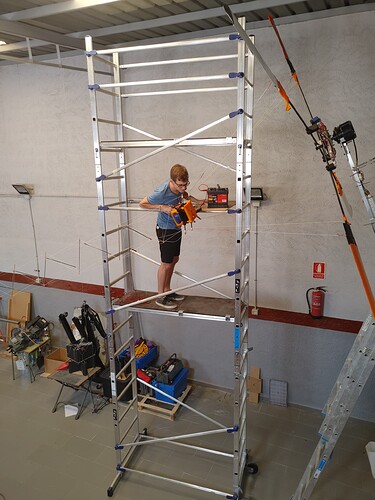Dear all,
I have been quiet for a while - but not lazy  I just published a video of what Team Tueddelpower has been working on for the last couple of month. It is not “airborne” yet - but imho shows great promise so I wanted to share:
I just published a video of what Team Tueddelpower has been working on for the last couple of month. It is not “airborne” yet - but imho shows great promise so I wanted to share:
Current Rotary Airborne Wind Energy Systems (RAWES) work without an active control system for the rotor using a pilot kite for passive control and lift. The pilot kite method has however limitations for reel in/out systems, automated launching & landing and larger systems.
A cyclic pitch system in the rotor could remove the need for a pilot kite by using the lift generated by the rotor itself and by making the rotor steerable. Combined with collective pitch it would also allow for reel in/out RAWES.
A rotor control system could be implemented using ailerons with servo motors in the rotor blades. The servos doing cyclic movements for each turn of the rotor might however have negative impact on their durability. As an alternative we have chosen a design derived from swash plates used in helicopters.
A swash plate needs to be connected to a rotary stable part of the rotor. In helicopters this is achieved using an airframe with a tail rotor. An airframe and tail rotor less alternative design is to build active rotation compensation into the swash plate. Such an active rotation compensator has been suggested (Moritz Diehl/Lukas Klein: Rotation Compensation for Rotary Kite
Systems) for RAWES to avoid twisting of the primary tether and for providing a rotationally stable attachment point for position sensors (e.g. GPS).
The result of these considerations is the rotation compensator based cyclic pitch control for Rotary Airborne Wind Energy Systems shown in the video in which the position of a swash plate is measured using an IMU and maintained by a small motor that spins the plate against the rotation of the rotor maintaining its position relative to the ground.
So where are we with our development? In the video you can see a test run in the hangar last week. The rotor on the wall is a mock up with a built-in motor to drive the system. It has built in load cells in all four arms allowing us to log the aerodynamic forces.
We used the test to see if the mechanics actually work, to fine tune the control algorithms and to collect data. Lots of data.
The test was very successful so the next test will be done actually airborne in the field. For that we will have to bring the team together in one place - which due to Covid restrictions might take a couple of weeks. So please be patient - I will publish the most beautiful crashes instantaneously.
The details about the control system and the data itself will be published as part of Daniels Master Thesis this year. As usual all the designs are open source and can be found in my OnShape and in Keith’s Github (see links under recent videos) - let me know if you need any additional information or help building your own version of this.
Thanks to Team Tueddelpower, to our incredibly talented Master Student Daniel and to Moritz Diehl for coming up with the idea of a rotation compensator.
Enjoy!
/cb


